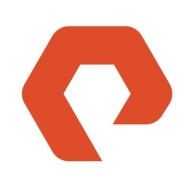


Find out in this report how the two Software Defined Storage (SDS) solutions compare in terms of features, pricing, service and support, easy of deployment, and ROI.
It does not require much management once you set up correctly, so it saves time, allowing an admin to focus on other work.
Their technical support has been perfect lately, so I would give it a 10.
The support is done through email and is not that great, making it a very problematic area I've been dealing with for over four years.
I would rate them an eight out of ten.
They always help me quickly and with great knowledge, which is essential for central storage.
I would rate technical support from DataCore SANsymphony a 10.
The customer support is perfect.
There are between 5 and 10,000 people using it in our organization.
Pure Storage FlashBlade is scalable.
There are no limits to scalability, which is essential for central storage.
In case there is any issue with any blade, the data is moved to another.
Technical support definitely needs significant improvement.
Its configuration should be easier.
One way Pure Storage FlashBlade can be improved is by having more compatibility between the FlashArray and FlashBlade.
there should be improvements in how to get and filter logs
DataCore SANsymphony can be improved with high availability as it offers synchronous mirroring between physical and separate sites to ensure business continuity and disaster recovery.
The area of DataCore SANsymphony that has room for improvement is the support.
My opinion is that support is generally very good. There are instances where they take longer to respond or resolve issues, especially when customers have urgent needs, but ultimately, resolution is achieved.
The pricing of Pure Storage FlashBlade is expensive compared to other products I used from other companies in the past, but one benefit is that they have built-in ransomware protection.
Regarding pricing, it is okay; we needed exactly this in size, and the price was a lot lower than competitors, making it good for us.
They have made some improvements regarding the pricing, but it's still too expensive.
The cost changed from a perpetual license to a subscription model.
Pure Storage FlashBlade's scalability is one of the most valuable features, and importantly, it always works, allowing for seamless upgrades.
We can plug in many blades, and we can have data up to one terabyte.
The best features of Pure Storage FlashBlade include better throughput and better performance.
Customers can extend storage with flexibility, as one is not obligated to purchase hard disks or controllers from the same storage vendor.
DataCore SANsymphony has positively impacted our organization because it is scalable and has a fundamental concept that aggregates and pools available storage resources, hiding the complexity, which makes it very simple.
DataCore SANsymphony's ability to enhance storage utilization is very good because it's agnostic and it can be deployed on every environment, which is perfect for my clients.



| Company Size | Count |
|---|---|
| Small Business | 11 |
| Midsize Enterprise | 11 |
| Large Enterprise | 21 |
| Company Size | Count |
|---|---|
| Small Business | 36 |
| Midsize Enterprise | 12 |
| Large Enterprise | 21 |
| Company Size | Count |
|---|---|
| Small Business | 7 |
| Midsize Enterprise | 11 |
| Large Enterprise | 53 |
FlashBlade is the industry’s most advanced scale-out storage for unstructured data, powered by a modern, massively parallel architecture to consolidate complex data silos (like backup appliances and data lakes) and accelerate tomorrow’s discoveries and insights.
Experience peace of mind with DataCore SANsymphony, the ultimate software-defined storage solution alleviating storage management challenges. Say goodbye to the complexities of managing different storage tiers and disruptions with SANsymphony's block-level storage virtualization technology, empowering you to automate capacity provisioning and data placement across diverse storage environments including SAN, DAS, HCI, and JBOD. Break down silos, control data placement, meet business continuity objectives, boost performance, and seamlessly expand or refresh hardware with SANsymphony. Benefit from features like asynchronous replication for disaster recovery, minimizing data loss, accelerating application responsiveness, and integrating new technology non-disruptively. Trusted by industry leaders like NASA, Thorntons, Inc., and TUI Cruises, DataCore SANsymphony guarantees unparalleled flexibility, scalability, and reliability, ensuring uninterrupted data access and application availability while reducing storage costs and inefficiencies.
NetApp Cloud Volumes ONTAP is an efficient storage management solution for managing and storing data in the cloud. It offers seamless integration with cloud providers, advanced data replication capabilities, and high data protection. With reliable performance, it is ideal for industries like healthcare and finance.
We monitor all Software Defined Storage (SDS) reviews to prevent fraudulent reviews and keep review quality high. We do not post reviews by company employees or direct competitors. We validate each review for authenticity via cross-reference with LinkedIn, and personal follow-up with the reviewer when necessary.